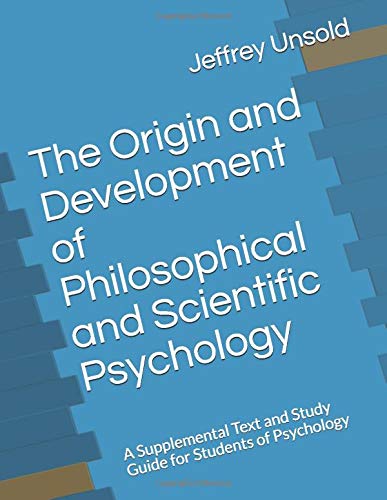The Origin and Development of Philosophical and Scientific Psychology: A Supplemental Text and Study Guide for Students of Psychology
Save 43%
Original price
$4.95
Current price
$2.84
Author: Mr Jeffrey L Unsold
Publisher: CreateSpace Independent Publishing Platform
Paperback:
ISBN 10: 1466305738
ISBN 13: 978-1466305731
This book is a supplemental text and study guide for students of psychology. Students will be quick to pick out the more elementary selections with which a course of studies might begin while intermediate and more advanced materials provide a more detailed analysis for the more advanced student. This book is designed as background for any course in psychology. Part one of this book begins with the history of psychology and describes how ancient and contemporary philosophy influenced the development of psychoanalytic theory, learning theory, existentialism, and humanistic theory. Then the author presents each of these theories in a positive light, dwelling upon those features of the theory that seem to be most useful and suggestive. Since existentialism and humanistic psychology is similar in nature, the author has elected to focus on the methods and clinical techniques of humanistic psychology, typical of Carl Rogers. To add support to each of these theories, documented research of successful treatments for different types of pathology for each of these systems is also presented in this inquiry. Following the presentation of part one of the book, the author then addresses the subject of scientific psychology. Part two begins with the history of psychology and describes how ancient and contemporary philosophy influenced the development of scientific psychology. Following this inquiry, the author then focuses on a variety of techniques, approaches, strategies, designs and rules of logic of the scientific method. Emphasis is placed on experimental research in which the experimenter manipulates one or more variables on another variable. To illustrate the use of statistics in research, the author presents five complete research projects. In each of of these studies, the author employs five different types of statistical measures to analyze the raw data. They are the t test, analysis of variance, the Pearson Product Moment Coefficient Correlation, the Spearman Rank Correlation Coefficient, and the Chi-Square. Then in the last part of this inquiry, the author describes the procedure used in research to prepare a research project for publication. For added help, a glossary has also been constructed in an effort to make it of maximum use to the reader. Not only does it include some unfamiliar terms that appear in the text itself but also has some additional terms that the student may encounter in lectures or supplementary readings.
Publisher: CreateSpace Independent Publishing Platform
Paperback:
ISBN 10: 1466305738
ISBN 13: 978-1466305731
This book is a supplemental text and study guide for students of psychology. Students will be quick to pick out the more elementary selections with which a course of studies might begin while intermediate and more advanced materials provide a more detailed analysis for the more advanced student. This book is designed as background for any course in psychology. Part one of this book begins with the history of psychology and describes how ancient and contemporary philosophy influenced the development of psychoanalytic theory, learning theory, existentialism, and humanistic theory. Then the author presents each of these theories in a positive light, dwelling upon those features of the theory that seem to be most useful and suggestive. Since existentialism and humanistic psychology is similar in nature, the author has elected to focus on the methods and clinical techniques of humanistic psychology, typical of Carl Rogers. To add support to each of these theories, documented research of successful treatments for different types of pathology for each of these systems is also presented in this inquiry. Following the presentation of part one of the book, the author then addresses the subject of scientific psychology. Part two begins with the history of psychology and describes how ancient and contemporary philosophy influenced the development of scientific psychology. Following this inquiry, the author then focuses on a variety of techniques, approaches, strategies, designs and rules of logic of the scientific method. Emphasis is placed on experimental research in which the experimenter manipulates one or more variables on another variable. To illustrate the use of statistics in research, the author presents five complete research projects. In each of of these studies, the author employs five different types of statistical measures to analyze the raw data. They are the t test, analysis of variance, the Pearson Product Moment Coefficient Correlation, the Spearman Rank Correlation Coefficient, and the Chi-Square. Then in the last part of this inquiry, the author describes the procedure used in research to prepare a research project for publication. For added help, a glossary has also been constructed in an effort to make it of maximum use to the reader. Not only does it include some unfamiliar terms that appear in the text itself but also has some additional terms that the student may encounter in lectures or supplementary readings.


